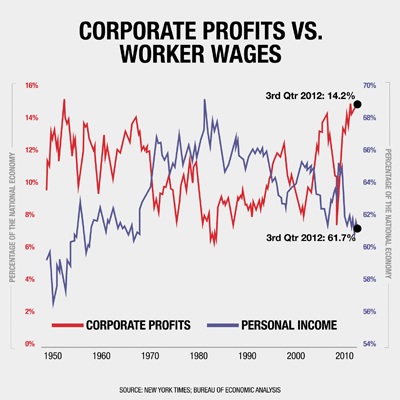Search News
For the Media
For media inquiries, call CWA Communications at 202-434-1168 or email comms@cwa-union.org. To read about CWA Members, Leadership or Industries, visit our About page.
89 Out of 100 Workers Don't Have Collective Bargaining
Working people face a harsh reality. The destruction of bargaining rights has resulted in staggering and growing inequality in this country.
This didn't happen by accident. It's the result of a decades-long, well-orchestrated, relentless campaign by corporations, the U.S. Chamber of Commerce and their front groups to strip away workers' organizing rights and the power to bargain for better wages and working conditions. It started with private sector workers back in the early 1980s and the growth of the union-busting industry. The campaign moved to the states, with right-wing support groups like ALEC -- the American Legislative Exchange Council -- drafting legislation to strip away public worker bargaining rights. Indiana and Michigan recently became the first states in more than a decade to pass right-to-work (for less) laws, another way to weaken workers' bargaining power.
Today, fewer than 7 out of 100 private sector workers and only 36 out of 100 public sector workers have bargaining rights.
Without bargaining rights, workers have no way to improve their wages and conditions and meet the power of their employers. And the decline in union membership means that bargaining is even tougher. It's as though every non-union competitor is sitting across the table from our bargaining teams.
 | The decline in collective bargaining is not happening in other countries. The global economy doesn’t have to mean stagnant real wages, no bargaining rights and no voice on the job. Workers in both established democracies and newer democracies in South America and Asia all have seen an increase in the percentage of workers with bargaining coverage, while U.S. workers have seen their bargaining coverage decline. Nations like Brazil, Germany and others maintain higher collective bargaining coverage despite the pressures of a global economy. |
 | Today, U.S. workers work longer hours for less. As the chart shows, U.S. wages increased along with productivity from 1947 to 1971. But since then wages have been decoupled from productivity, creating a more than $500 gap. Because workers can't get their share of profits individually, it means fewer workers are sharing in productivity gains. |
 | So who's benefiting from workers' labor? This chart makes it crystal clear. Corporate earnings are skyrocketing, and were up 18.6 percent over a year ago. Corporate after-tax profits accounted for a record 11.1 percent of the U.S. economy last quarter. Wages, that's a different story. Wages actually fell to their lowest ever share of the U.S. economy, equaling 43.5 percent of the Gross Domestic Product. Until 1975, wages almost always accounted for at least half of the GDP. |